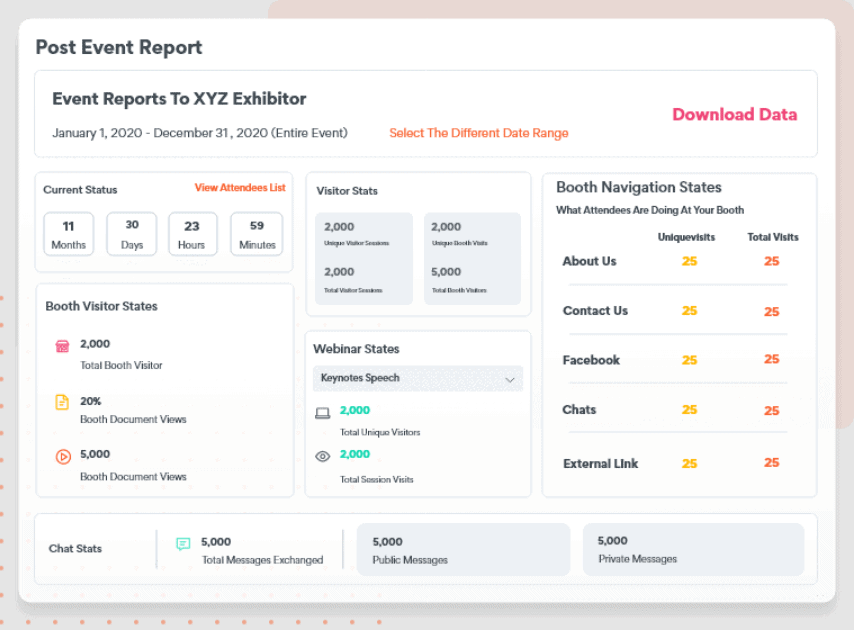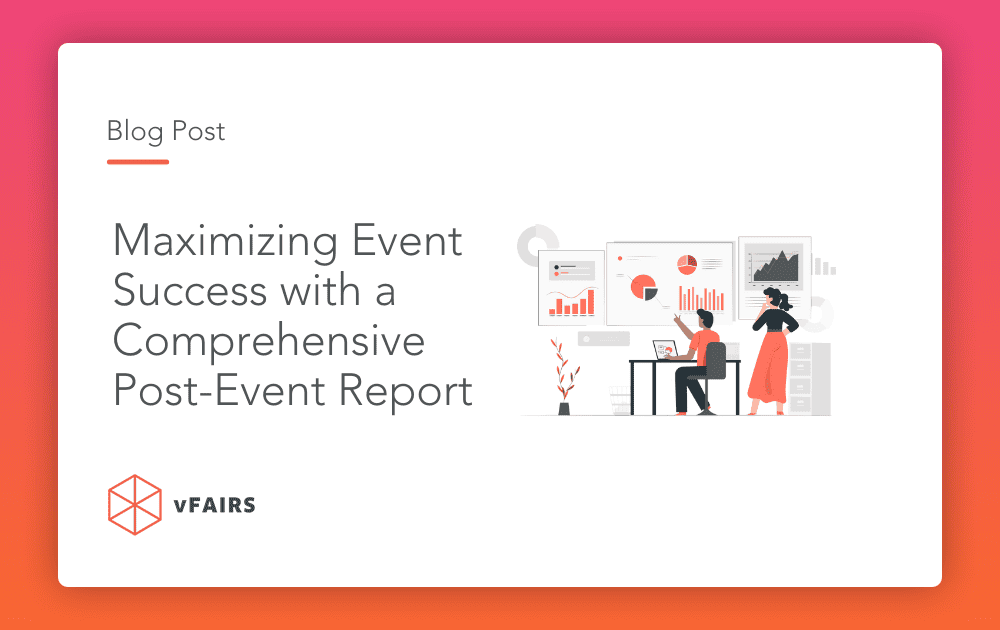Hosting a successful event takes meticulous planning, hard work, and strategic execution. However, the journey doesn’t end when the event wraps up. It’s equally important to kick back, take a breather, and evaluate the event’s performance to gather insights for future improvements.
In this blog, we’ll dive into the importance of a comprehensive post-event report and how it can level up your event planning game. Whether you’re an event organizer, marketer, or business owner, understanding the power of post-event reports can make a significant difference in your event’s success.

Why You Need a Post-Event Report
Imagine hosting an event, investing considerable time and resources into its planning and execution, and then being left in the dark about its impact. A post-event report serves as your trusty compass, navigating you through the sea of event data and providing insights into key aspects of your event’s performance.
Event reporting goes beyond mere numbers and statistics, offering a comprehensive evaluation of your event’s strengths, weaknesses, and opportunities. The insights derived from this post-event analysis serve as valuable lessons for making your next event even better.
Here’s a breakdown of why a post-event report is indispensable:
Measure Event Success
A post-event report opens a window into understanding the true success of your event. It quantifies key metrics such as attendance, engagement, and revenue, shedding light on the event’s tangible impact.
Identify Opportunities for Growth
While celebrating successes is crucial, post-event reports also help in finding untapped opportunities. By looking into attendee feedback and behavior, you can pinpoint areas for growth and improvement that can lead to even greater success in future events.
Refine Marketing Strategies
In-depth analysis of ticket sales and real-time event analytics like registration data provide valuable insights into which marketing channels were most effective. This information in the post-event evaluation report allows you to fine-tune your marketing strategies, ensuring you reach the right audience with the right message.
Enhance Customer Relationships
Events are more than just transactions; they’re the key to building relationships. Post-event reports help you understand attendee preferences and behaviors, enabling you to tailor your marketing efforts for better audience engagement.
Boost ROI
By evaluating the success of past events and identifying areas for improvement, you can significantly increase your return on investment (ROI) for upcoming events.
Types of Post-Event Reports
Post-event reports come in various types, each focusing on specific aspects of your event:
- Registration & Attendance Reports: Compare registration numbers to actual attendance, offering a key indicator of pre-event engagement and the effectiveness of marketing and ticket pricing strategies. Attendance Reports provide insights into attendance trends over time.
- Engagement Reports: Analyze attendee participation to uncover preferred subject matter and content types, allowing you to tailor your post-event marketing campaigns more effectively. These reports offer valuable insights into what resonates most with your audience.
- Exhibitor Reports: Gather valuable insights into exhibitor performance, including booth traffic, scans, and attendee engagement with booth content, to demonstrate the event’s ROI to partners.
- Lead Capture Reports: Essential for event hosts, sponsors, and exhibitors, providing insights for effective lead follow-ups.
- Social Media Reports: These reveal how your event was discussed and shared on social media platforms, offering insights into attendee sentiment and social media impact.
- Meeting & Chat Reports: Essential for B2B events, these event wrap-up reports detail the number of meetings held, accepted, and declined, providing insights into the value created for participants.
- Marketing Reports: These dive deep into your event marketing campaign, offering insights into target audiences, strategies, tactics, and metrics.
- Lessons Learned: Capturing key takeaways, both positive and negative, these reports help you make informed decisions for future events.
Mastering the Art of Post-Event Reporting: Unveiling the Insights
Alright, let’s get to work. The curtains have closed, the last chat box has been signed off, and your event has successfully concluded. Now, what’s next? It’s time to unveil the magic of post-event reporting!
The Metrics That Matter
First up, let’s talk numbers. What event-based metrics should you track and include in your post-event report? Well, the usual suspects include attendance, registrations, ticket sales, and sessions attended. But don’t stop there! Get specific to your event type.
- Trade Show Metrics: Keep an eye on the products ordered, booths visited, meetings scheduled, and leads captured to gauge the success of your trade show.
- Career/Job Fair Metrics: Evaluate the jobs viewed, jobs applied to, booths visited, and meetings scheduled to measure the impact of your career or job fair.
- Conference Metrics: Monitor the sessions attended, chats hosted, documents viewed or downloaded, and links clicked to assess the performance of your conference.
Setting Objectives and KPIs
What do you want to achieve with your event? Is it brand awareness, lead generation, or something else? If you have defined clear objectives and relevant KPIs before starting the event, these reports will provide a clear measure of your event’s success based on those objectives and KPIs.
Structuring the Report
When structuring your post-event report, think of it as telling a story. Start with an executive summary, giving a quick overview of the event’s highlights. Then, search into the metrics, objectives, and KPIs you defined earlier. Share the details on what worked and what didn’t.
Here’s all the important information that you need to add to your post-event report:
- Event Overview: This includes all the high-level information – date, venue, speakers, ticket price, etc.
- Event Objective: Fill this section by telling the purpose of the event.
- Metrics: Mention the metrics you draw up before the event and compare them with what you have achieved.
- Achievements and Recommendations: Mention the details of what worked well and what we can improve in future events.
- Budget: Give a high-level view of budget performance.
- Attendee Information: Use this section to mention the number of details from attendees including the number of attendees, number of tickets sold, age groups, number of students & professionals, etc.
- Event Venue: Mention all the information, observations, and recommendations regarding the venue including operations, maintenance, provided facilities, and services.
- Registration & Check-Ins: Use this section to put insights and suggestions regarding the registration and check-in process.
- Logistics: In this section, cover the logistics part of your event; everything from setup to pack up.
- Feedback: Use this section to mention key insights received from the delegate feedback form, testimonials, and social media mentions.
- Promotional Activities: Mention the summary of promotional activities through the website, social media, and other forums with visuals, cost, and reach.
- Visual Highlights: Use this section to add some event visuals to showcase the exciting moments and highlights of the event.
Leverage AI for Quick Insights
Efficiency is the name of the game. Nobody wants to spend endless hours crunching numbers. That’s where technology comes to the rescue. vFairs’ AI reporting chatbot can do the heavy lifting for you. It churns out event reports faster than you can say “post-event analysis.”

This chatbot is your event analytics companion, simplifying the complex process of sifting through mountains of event data. Instead of spending a long time looking through reports, event organizers can now ask the chatbot questions in a conversational tone. In mere seconds, it delivers comprehensive insights, eliminating the need for manual research and hours spent scanning reports.
This efficiency empowers event organizers to make informed decisions swiftly, ensuring timely and effective improvements to their events. Say goodbye to the grueling process, and welcome the ease and speed of our AI chatbot, your event analytics companion.
Besides our event analytics chatbot, we also provide comprehensive event reports in CSV format. These reports offer insights into attendee data and engagement metrics, giving event organizers structured and customizable data. Whether you choose our chatbot for ease or CSV reports for flexibility, we’re here to simplify data-driven decision-making for your events.
Plus, if you ever get stuck sorting a detailed CSV report, remember that vFairs offers dedicated PM (Project Manager) support. They’re like event-reporting superheroes, ready to assist you. They can help you at every step of the event planning process; from day one to curtain call. You can simply ask your PM for the report you want to generate, and they will get it right to you.
Conclusion
Post-event reports make it easier for event organizers to navigate the seas of event planning and evaluation. They offer invaluable insights into your event’s success, helping you measure its impact, identify growth opportunities, and optimize your marketing strategies. With the correct data and tools, you can impress sponsors, build better customer relationships, and increase your ROI for future events. Don’t let your event’s data go to waste!


